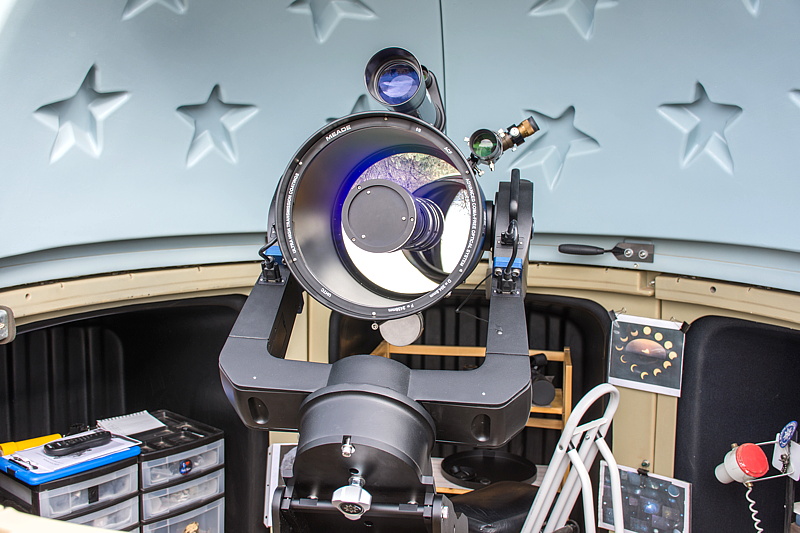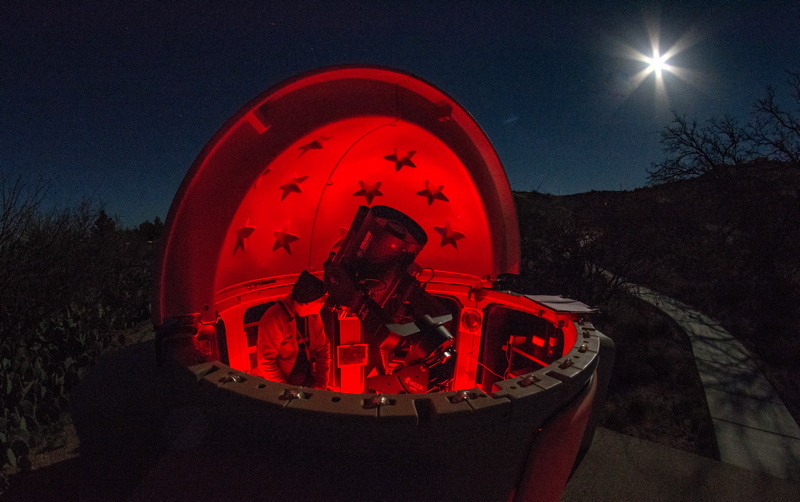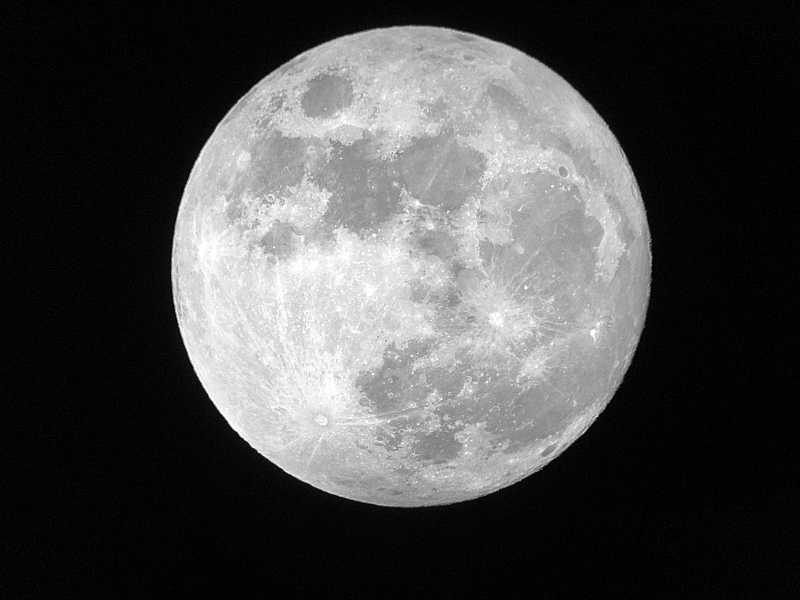12" LX600 Polar Alignment, Checkout, and Moon iPhone Imaging
Posted: 22 February 2016
After the successful First Light with the new Meade 12" LX600 telescope on Wednesday, 17 February 2016, the sky became cloudy. Friday, 19 February 2016, I went to the observatory to take updated photos of the observatory and some accessories I previously used with the 8" LX200-ACF telescope. Here is a photo I took showing the 12" LX600 optics:

Three new photos of the 12" LX600 and the observatory have been added to the Photo Albums: Observatory page. Check them out there or click the thumbnails below.
 Mike and 12" LX600 |
 Observatory Interior (fisheye lens) |
 Observatory Interior (fisheye lens) |
I also did an adjustment of the OTA counterweight, balancing for the 2" diagonal and 24mm UWA eyepiece. Only a single weight was needed, not both. The final thing I did that day was to tweak the leveling of the tripod/wedge. I should have done that BEFORE the telescope was mounted, but it was not too difficult to raise a tripod leg the inch or so to obtain the necessary amount of leveling adjustment.
Saturday, 20 February, I took photos of some more accessories, as well as photos for the animated POD open/close on the Cassiopeia Observatory web site home page (bottom). The Equipment page has been updated with new photos.
The sky finally cleared on Sunday, 21 February, allowing for checkout of the 12" LX600 in the POD.
|
Open: Sunday, 21 February 2016, 1755 MST Temperature: 87°F |
Session: 922 Conditions: Clear, hazy |
First, I synced the observatory clock to WWV. Since this night would be the first power on and polar alignment of the 12" LX600 I delayed powering it on until some stars were visible. In the meantime I did some preliminary measurements for pier height and location. These are what I determined:
Top of tripod = 30-1/8" (adequate over the POD wall OTA viewing of horizon)
Door (on south) to wedge spacing = 22"
Eyepiece (on north) to wall spacing = 21"
N-S center of tripod aligned with south edge of E and W wall supports
A pier height of 28" should work fine. I will evaluate that decision over the next few nights as I use the telescope. As expected, the POD Zenith Table (PZT) will be required to allow viewing at high southern and northern elevations, both visually through the main OTA and by the StarLock telescope. I hope to start PZT construction soon.
1814 MST: sunset. 1818 MST: Moon rise over the hill to the east. I used the Moon for a rough alignment of the finderscope.
1858 MST: powered on the LX600. I used the Wireless AutoStar II handcontroller this night (and will continue to use it on future sessions). I set the AutoStar mount setting to Polar and did a One Star alignment. This took some time as I had to adjust the wedge latitude and azimuth to point at the North Celestial Pole. 1921 MST: completed the mount and AutoStar alignment successfully. Used the star Sirius to refine the finderscope alignment.
Did a GOTO M42 (Orion Nebula) and viewed it using the 2" 24mm UWA eyepiece (102X). Great view even with the bright moonlit sky.
I then added the "Sun as Asteroid" to the AutoStar. This will facilitate future solar viewing with the telescope and solar filter.
Next, I set up for observatory photography using the D7200 DSLR with an 8mm fisheye lens. This photo was taken at 1942 MST, f/22, 20 seconds, ISO 1600, and shows the POD with the 12" LX600 telescope and the bright Moon in the east:

This photo, f/11, 2 seconds, ISO 1600, shows me at the 12" telescope:

2000-2108 MST: tested each of my 1.25" and 2" eyepieces and measured the actual field-of-view (FOV) for each eyepiece using the star Rigel. Did the tests and measurements with each eyepiece on the 2" visual back and through the 2" star diagonal. (I will post the results when I finish the FOV measurements; I still have to do the DSLR measurements.) All of my eyepieces worked fine at both positions.
After finishing the FOV measurements I used the 9mm eyepiece (271X) to view the separation distance of the Rigel component stars (which is similar to the Sirius A-B separation). I then tried to view Sirius B (the "Pup Star"), 271X, but without success. Sirius was just too bright.
2115 MST: Jupiter had now risen over the hill to the east. I did a GOTO Jupiter; the StarLock placed it just outside of the 9mm FOV. (I have not yet adjusted the StarLock alignment offset.) Jupiter was too low for good viewing, but disks of all four Galilean Moons were visible at 271X. Lots of structure was occasionally visible in the cloud belts.
Then did a GOTO the nearly Full Moon. The StarLock placed it just outside of the 7x50 finderscope FOV. That was a surprise and may be partly due to inaccurate AutoStar lunar position calculations. Once I had the Moon in the 9mm eyepiece I could see a very slight terminator. Switched to the 24mm UWA eyepiece (102X). The entire lunar disk was visible the FOV, but the Moon was VERY bright! I added one of the 2" variable polarizer filters as a "moon filter" which made the view more comfortable.
I then attempted an afocal iPhone 6s Plus handheld photo of the Moon using the 24mm eyepiece. I could not get the entire disk, as seen in this slightly cropped image:

However, using a 2" 30mm eyepiece (81X) I was able to capture the lunar disk afocally and handheld as seen here (uncropped):

I then used the Baader 8-24mm Zoom Eyepiece. The entire lunar disk was not visible at 24mm, but the views of the Moon using all the focal lengths of the zoom eyepiece were super. Slewed to Jupiter and viewed it with the zoom eyepiece. Seeing was still not good however.
My last test for the night was to checkout the GC W-Fi Adapter and my iPhone 6s Plus using the iOS apps SkySafari 5 Pro and ScopeBoss. Both apps could connect to the telescope but for some reason could not receive a response from the telescope. I will have to troubleshoot this problem on a future session.
2220 MST: finished all my tests and initial checkout of the 12" LX600 in the observatory. Parked the telescope using the default "Park" position. That position had the telescope pointed upward. I may change the Park position in the future to make it easier to reach the top of the telescope when parked.
|
Close: Sunday, 21 February 2016, 2234 MST Temperature: 57°F |
Session Length: 4h 41m Conditions: Clear, breezy |
Comments are welcome using Email. If you are on Twitter you can use the button below to tweet this report to your followers. Thanks.
Cassiopeia Observatory Home Page
Copyright ©2016 Michael L. Weasner / mweasner@me.com
URL = http://www.weasner.com/co/Reports/2016/02/22/index.html
